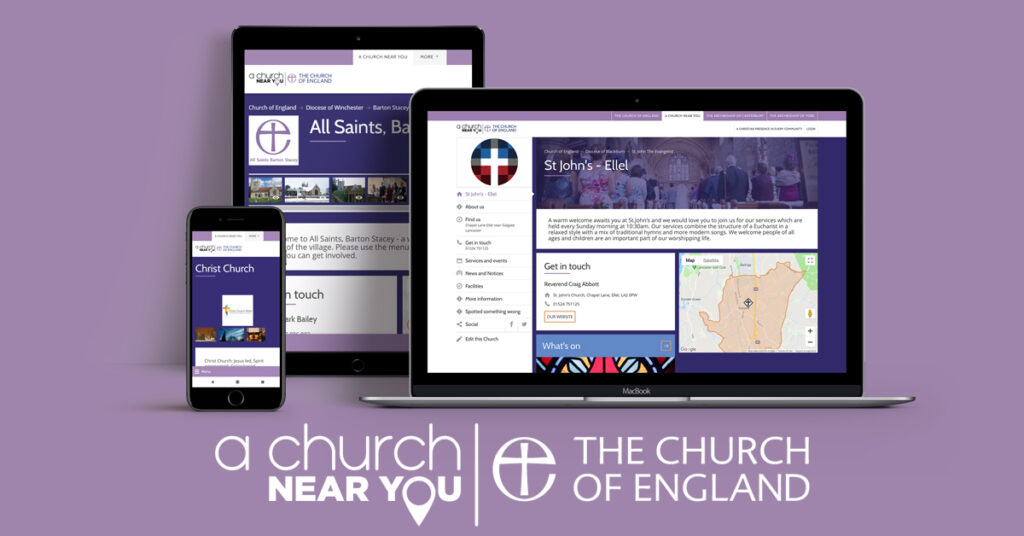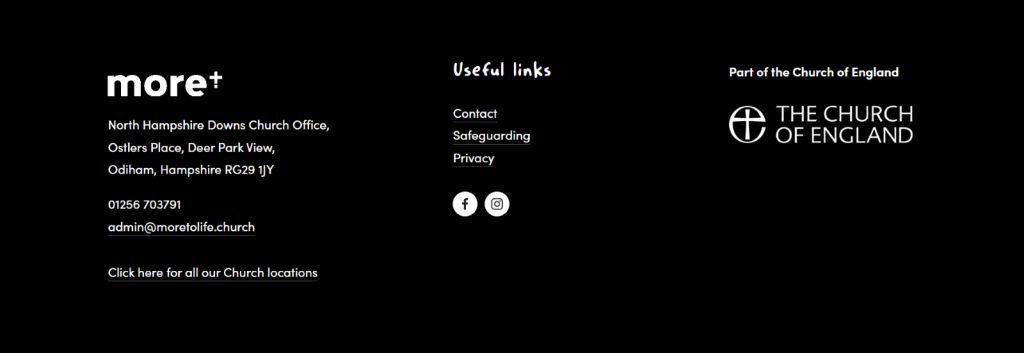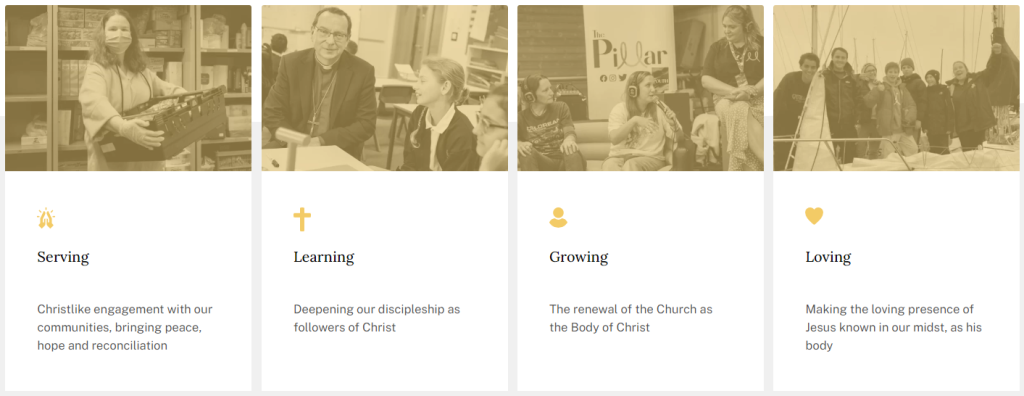Getting Started
Free Church Website
Some churches use AChurchNearYou (ACNY) exclusively as their main website, which is a great place to start if you don’t currently have any other online presence. Evey Church of England church has a free listing and can develop it to add pages, images and events – it works like a mini website.
When managing your ACNY page, it’s important to keep the information up to date, as this will probably be the place visitors to your church will find out about services, and how to find the church. Make sure you add some cover photos too, so that people know what your church building, as well as the people that make up the church, looks like.
Additional functionality is being added all the time to the ACNY website – there can now be multiple editors, the default administrator will be the incumbent, and there is now the option to create benefice pages that populate the pages of the individual churches in the benefice. Find out more about AChurchNearYou here.

Church Website Creation Platforms
When it comes to building your church website, there are several options on the market that cater specifically to churches. This means that they’ll know what sort of pages you’ll need on your website, and can help you set up things like donation pages directly on the website. The potential downside of these church website creation platforms is that they’re not necessarily the cheapest option – the annual cost can range from around £175 to £620, and you may also need to pay an upfront fee for the website build itself. (The costs quoted below are accurate at the time of writing, and may vary.)
ChurchDesk
While ChurchDesk is primarily a church management system, they do offer a church website building service, as well as a way to transfer an existing website to the ChurchDesk platform. You can build your own website from scratch or use the templates available. The website will integrate with all other ChurchDesk systems, which means it’s easy for visitors to sign up for events and the newsletter directly on the website. Basic ChurchDesk plans start from £52 +VAT per month.
Website Build Cost: £1,390 +VAT
Website Transfer: Up to 25 Pages: £890, Up to 50 Pages: £1,500
Church Edit
Church Edit work with churches across the UK to build their websites. The software is easy to use, even if you have never created a webpage before, and you can always contact Church Edit’s support team for assistance with your site. You can create unlimited pages with Church Edit’s simple page builder.
Annual Cost: £175
UKChurches
UKChurches will build your website for you, and can set up a domain for you if you don’t have one already (domain ownership is typically priced separately, and is around £30 a year). With UKChurches, you’ll get unlimited Support Requests, a free re-design every two years, and can have up to 100 pages on your website.
Annual Cost: £428.40
DIY Website Creation Platforms
If you’re willing to spend some time building your church website yourself, there are several build-it-yourself website tools available. These tend to be significantly cheaper than paying a company or freelancer to build your website for you. The cost of the website itself will typically be between £50 and £100 a year, which should include the hosting costs, and potentially the domain name (the website address).
One of the main benefits of creating your church website yourself is that you’ll retain control every step of the way. So, if you need to make any stylistic or copy changes, it’s easy to update the website yourself. Examples of these website creation platforms include:
Wix
Wix is an easy-to-use website builder which offers over 900 free, customisable website templates. Alternatively, you can start from a blank canvas on their website builder. Like the platforms below, Wix has an intuitive drag and drop website editor, so you don’t need any technical expertise to create your church’s website. Wix can also set up your web hosting for you, as well as secure you a custom domain name.
WordPress
Like Wix, WordPress is an intuitive platform that is incredibly simple to use. You simply pick a theme, then, drag, drop, and copy-paste pre-built block patterns on any post or page with the built-in block editor. You can also customise your fonts and colour palette, so that you keep your branding consistent across your website. WordPress is one of the most popular website building platforms on the market – the diocesan website has been created on WordPress.
Squarespace
With Squarespace, you’ll have access to numerous easy-to-edit website templates, and no knowledge of coding is needed! It’s simple to build flexible, easy-to-customise pages, and add as many sections as needed. You can even manage your Squarespace site while on the go through their app.
Freelance Website Designers
If you’d prefer to get an individual or company to design your church’s website, this will typically mean a more bespoke service, but it could cost you more upfront. Freelance website designers will usually charge between £500 and £1,000 for a website build, though there will also be annual maintenance fees. Local agencies include:
Church Management Systems
Alongside creating a website, many churches use church management systems to help with the day-to-day organisation of church life. This may include managing your contact list, events, rotas and finance, as well as reporting and stats tools. Such platforms also offer a way to centralise all of your church communications, such as newsletters and emails. Examples of church management systems include:
Updating Your Church Website
Church Website Examples
There are lots of examples of great church websites from across our diocese! We’ve chosen a couple of examples below which have been well designed and are easy to use:
Andover Parish
A modern, picture heavy website with bright colours and strong branding.
Bright Waters Benefice
A clear and easy-to-navigate website for the whole benefice, located in the Whitchurch Deanery, with further information on each church. Great detail on the history and design of the churches, with current information on what each church is up to available with just a few clicks.
Bursledon Parish
A welcoming and easy-to-use website. Good number of images but could do with more images from the life of the parish rather than stock images.
Romsey Abbey
An easy-to-use website. The site is a bit busy, but the amount of content may reflect the amount going on within the Abbey, so unavoidable!
Northanger Benefice
A beautifully laid out website, with a clear, clean design. Great information about each of the churches in the benefice, as well as a helpful map embedded on each of the church pages, so visitors can easily find their way there!
North Hampshire Benefice – More to Life Churches
A well thought-out and planned website with lots of great images from around the benefice. All text is clear and concise. Easy to find what you’re looking for.
St Peter’s Yateley
A well designed website with an attractive layout and easy navigation. There are lots of lovely photos of the St Peter’s community across the website, which provides an authentic view of the church.
Website Layout
When it comes to the layout of your church website, most sites have similar basic layouts, such as a homepage, pages detailing upcoming services and events, a contact page, and pages exploring church life. Typically, you’d have a ‘megamenu’ at the top of the homepage, which allows visitors to search for the page they wanted. Your website should probably include:
- Homepage
- Services/Events/What’s On/Worship/Calendar
- About (Meet the Team, Vision and Values, Church/Churches Information)
- Church Life (Life Event Services, Alpha, Groups, Creation Care)
- Children and Youth
- Contact (How to Find Us)
- Safeguarding
- Privacy Policy
Please note that a link to your safeguarding information must be included on your homepage. This should include a link to your safeguarding policy (an example template can be found here) and the contact details of your Safeguarding Officer(s).
Optional:
- Vacancies
- Donate
- Parish Magazine
- Blog/News Items
- Podcasts
- Sermon Videos
The main thing to consider when planning the layout of your website is how a visitor will interact with the site. Do they have to click through lots of pages to get to the page they need? Is it easy to find all the relevant information? Essentially, you need to consider the user experience, ensuring that your website is as easy to navigate as possible. Perhaps ask a non-Christian friend or focus group to review the text and layout of your website, making sure it’s clear and accessible.
You should also think about whether your website is inclusive – does it use alt text, and have you thought about the font size, for those with vision impairments? Could your website offer voice command functionality or a contrast mode? Try to ensure that the various elements on your website can be experienced in more than one way, such as through text, imagery, video and audio.
Website Footer
Most church websites have a footer at the bottom of the page, which may have links to key webpages, your church social media accounts, and contact details for the church or benefice. Examples include:




In your footer, you may wish to include:
- Your church logo
- The church address
- Contact details
- Safeguarding information
- Your church’s Privacy Policy
- Social media Links
- Newsletter signup options
Things to Consider on Your Church Website
- Text: Make sure that you are always clear on your messaging, ensuring that the content is informative, yet easy to read. You should also regularly update information and details such as service times and upcoming events
- Logo: Does your church or benefice have a logo? If not, could you create one? Sites like Canva allow you to create logos for free, which can be used across your website and other media. As a nonprofit, your church also has the option to sign up for a Canva for Nonprofits account. This will allow you to access more features, without needing to pay for an account.
- Branding: Do you have brand colours and fonts, to keep everything consistent across your website? HEX codes can be a useful way of ensuring that you keep the same colours across the board.
- Imagery: Does your website use enough images? Are these stock images, or images of parish life? Real images are preferable, but free stock images can be found via sites like Unsplash and Pixabay. The images found on these sites are not subject to copyright. This means that they can be used on your website or social media channels without you having to pay to use them.
- Icons: Could you use consistent icons across your website, to depict certain themes?

